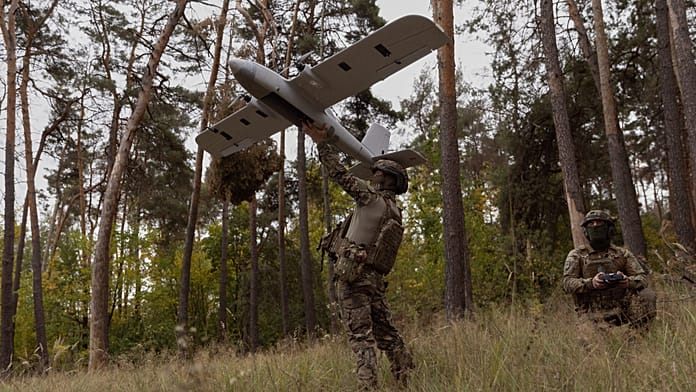
When it comes to drone warfare, European armed forces are making the “major mistake” of focusing too much on equipment and not enough on training people to command them, a Ukrainian specialist told Euronews.
“Our commanders learn every day on the front line. They’re fighting for four years almost on a daily basis. And Europe starts way beyond. But they discuss the equipment dimension, but they don’t discuss the experience and tactics dimension,” Fedir Serdiuk, the co-founder of MOWA Defence, told Euronews on the margins of the European Defence & Security Conference held in Brussels.
“I don’t see as many training centres being built as factories and it’s a major mistake. Not only for technical skills but also for tactical skills,” he added.
His company employs battle-hardened Ukrainian veterans to advise foreign armed forces, especially on drone warfare. MOWA Defence was, for instance, involved in a recent NATO exercise that involved British, Polish and Australian troops.
“First the conversation should be about humans and skills and second about equipment. You first talk about training centres for officers and soldiers, then about factories,” Serdiuk said.
“Because the limitation won’t be really in production. Even in Ukraine, we showed that you can raise the production quite rapidly. The problem is to train people and equip people with skills and knowledge of (drone) warfare.”
‘You have to focus on skills’
Russia, which launched 5,600 drone attacks against Ukraine in September, aims to produce five million drones a year. Kyiv, meanwhile, produced few drones before Moscow launched its full-scale invasion in February 2022, but now aims for the two million annual mark.
About 100 different types of drones are estimated to be in use in the conflict, ranging from small toy-sized models to systems with 20-metre wingspans.
Ukraine has used drones to great success for reconnaissance, artillery spotting and direct attacks, including Operation Spiderweb, in which it used small drones smuggled into Russia to remotely neutralise strategic military bombers.
Destroying drone factories has therefore become a priority military objective for both sides. This is why the human factor is particularly crucial, Serdiuk argued.
“In some (Western) nations, they have a hundred people capable of using drones, but a million drones being produced. It’s impossible. You have to focus on the skills.”
“One day Russian ballistic missile can strike over some factory and you won’t have the drone Alpha, but you will have the drone Bravo. Our soldiers are less focused on one piece of equipment, maybe they don’t master this piece of equipment that much, but they are more flexible and use different types of equipment,” he said.
‘Russia not afraid of Tomahawks’
Despite adopting a Drone Strategy in 2022 to safeguard its strategic autonomy in this area, the EU appears to be waking up to the issue of drones following a spate of airspace violations over the past few weeks in Poland, Estonia, Romania, Germany and Denmark.
EU leaders have since discussed the possibility of erecting a so-called drone wall, which the European Commission has designated as a flagship project in its recently unveiled proposal to boost the bloc’s defence readiness by 2030.
They are next scheduled to discuss the topic at a summit in Brussels on Thursday. According to draft conclusions seen by Euronews, they will stress that EU member states need to focus on joint efforts to “enhance their anti-drone and defence capabilities, in a coordinated manner”.
All agree that the Ukrainian experience, and rapidly evolving technology, is invaluable.
When Commission chief Ursula von der Leyen unveiled a €2bn package for Ukraine’s drone defence last month, she for instance stressed that “this allows Ukraine to scale up its drone production capacity and will allow the EU to benefit from this technology.”
Ukraine and Denmark have since signed a deal to allow for the joint production of drones in the Nordic country. Ukrainian President Volodymyr Zelenskyy also appears keen to do the same with the US in a bid to secure continued military support from Washington, especially long-range strike capabilities.
Yet for Serdiuk, “Russia is not afraid of the Tomahawk missiles, they’re not afraid of the nukes, they’re not afraid of the planes.”
“They’re afraid of the people who know how to use whatever equipment they have, rifles and so on.
“Take a look at how Russia shares (its) experience with North Koreans. They invited them to fight alongside, not because they needed so much these people, but because they allowed them to learn,” he said.
















